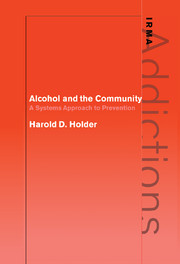Book contents
- Frontmatter
- Contents
- Series editor's preface
- Acknowledgements
- 1 The community system of alcohol use and alcohol problems
- 2 Consumption System
- 3 Retail Sales Subsystem: alcohol availability and promotion
- 4 Formal Regulation and Control Subsystem: rules, administration, and enforcement
- 5 Social Norms Subsystem: community values and social influences that affect drinking
- 6 Legal Sanctions Subsystem: prohibited uses of alcohol
- 7 Social, Economic, and Health Consequences Subsystem:community identification of and responses to alcohol problems
- 8 Community-level alcohol problem prevention
- References
- Index
4 - Formal Regulation and Control Subsystem: rules, administration, and enforcement
Published online by Cambridge University Press: 22 September 2009
- Frontmatter
- Contents
- Series editor's preface
- Acknowledgements
- 1 The community system of alcohol use and alcohol problems
- 2 Consumption System
- 3 Retail Sales Subsystem: alcohol availability and promotion
- 4 Formal Regulation and Control Subsystem: rules, administration, and enforcement
- 5 Social Norms Subsystem: community values and social influences that affect drinking
- 6 Legal Sanctions Subsystem: prohibited uses of alcohol
- 7 Social, Economic, and Health Consequences Subsystem:community identification of and responses to alcohol problems
- 8 Community-level alcohol problem prevention
- References
- Index
Summary
Introduction
The function of the Formal Regulation and Control Subsystem is to place limits on the physical and economic availability of alcoholic beverages. Most societies establish rules and controls governing the sale and availability of alcohol. In industrialized societies, these take the form of formal laws and regulations. In fact, alcohol may be, on average, the most regulated of all legal retail products. Formal regulations typically cover the production, import, wholesale distribution, and retail sales of alcohol. The government may hold a monopoly on wholesale or retail sales of alcohol. If alcohol production and retail sales are in the hands of private corporations and individuals, these activities usually are subject to licensing and regulation.
Physical availability of alcohol may be limited through regulations controlling: the forms in which alcohol can be sold; the types, numbers, densities, and locations of retail outlets; the hours and days of the week retail sales are allowed; the minimum age to purchase or drink alcohol; serving practices; the potential liability of those serving alcohol; and the social accessibility of alcohol. Economic availability of alcohol may be regulated through taxation of alcohol sales, alcohol price restrictions and controls, and restrictions on the promotion and advertising of alcohol.
Formal regulations are publicly codified statements of societal values. Thus, the Formal Regulation and Control Subsystem is influenced by the Social Norms Subsystem, which reflects social expectations related to the use of alcohol and the community's level of concern about alcohol-involved problems.
- Type
- Chapter
- Information
- Alcohol and the CommunityA Systems Approach to Prevention, pp. 64 - 73Publisher: Cambridge University PressPrint publication year: 1998

